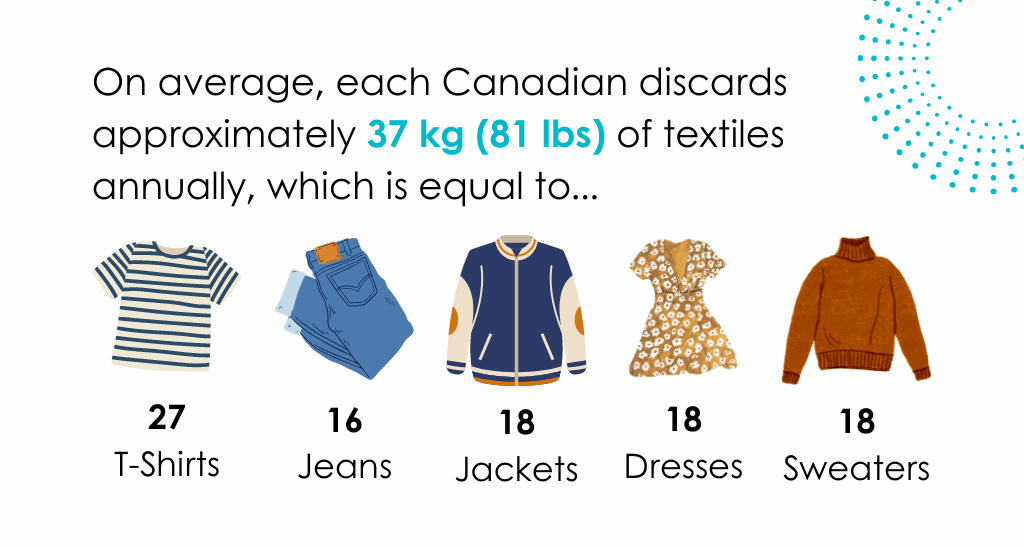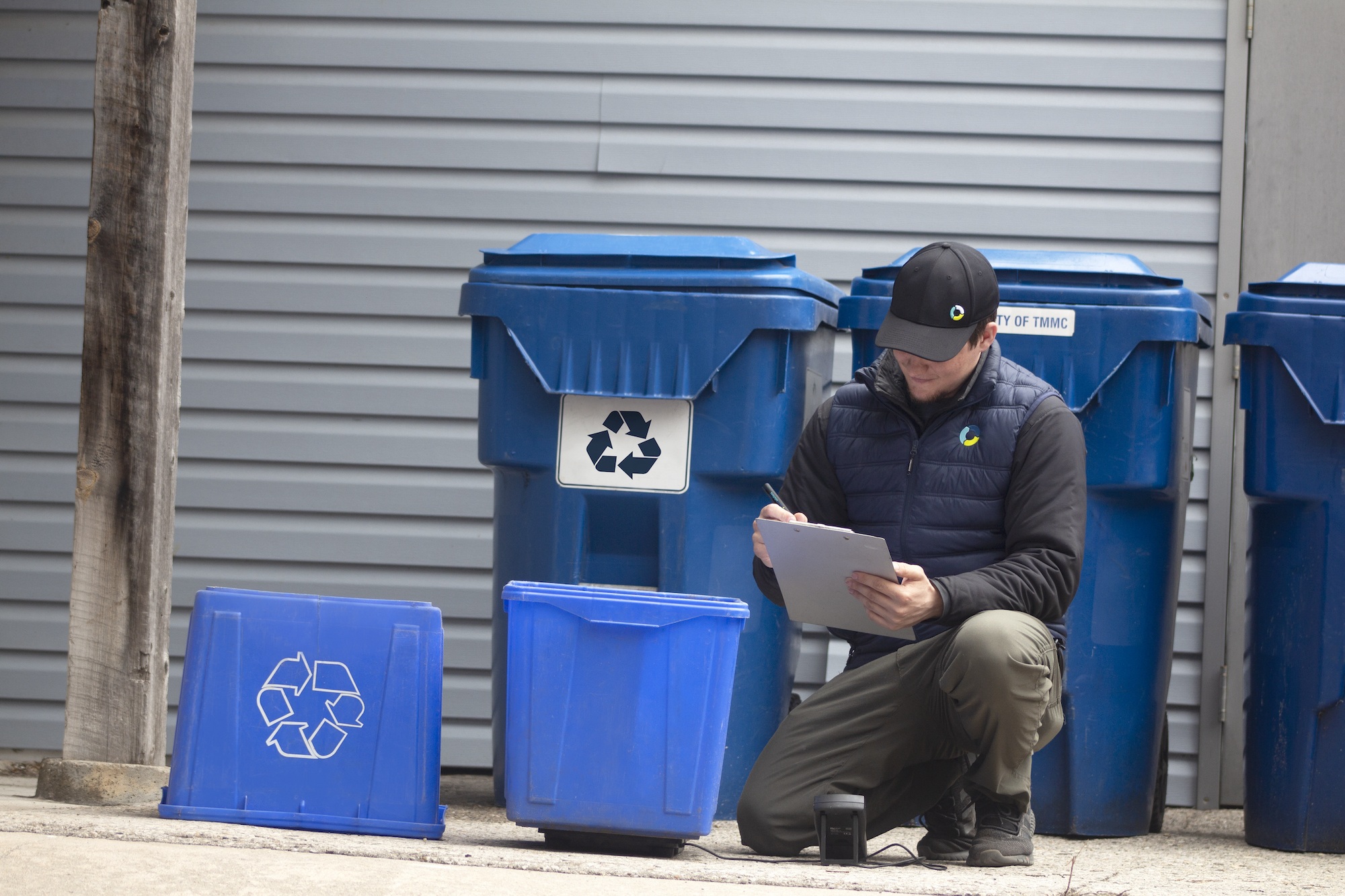In a world increasingly focused on sustainability, the issue of textile waste has emerged as a significant environmental challenge. Canada, like many other countries, faces a growing problem with textile waste, driven by the rise of fast fashion and consumer habits. In Canada, we now purchase 60% more clothing than we did 20 years ago, yet these items remain in our closets for only half as long. Understanding the scope of this issue and exploring solutions is critical to mitigating its impact on our environment.

Textile Waste in Numbers
A 2023 study by the University of Waterloo revealed that Canadians dispose of nearly 500 million kilograms of fabric each year. This staggering amount includes clothing, household linens, and other fabric-based products. Unfortunately, most of these textiles – about 85% – end up in landfills.

On a per-person basis, this means that each Canadian throws away approximately around thirty-seven kilograms (81 pounds) of textiles every year. This waste contributes to the rapid filling of landfills and creates significant environmental concerns.
Environmental Impact
The environmental impact of textile waste is multifaceted. Did you know when textiles are sent to the landfill, they decompose slowly, with synthetic fibers taking hundreds of years to break down? As these materials decompose, they release harmful greenhouse gases, such as methane, into the atmosphere. Natural fibers, while biodegradable, also contribute to methane emissions during decomposition.

Moreover, the production of textiles is resource intensive. It involves high water consumption, energy use, and the release of chemicals and dyes that can contaminate water sources. When textiles are discarded, all these embedded resources are effectively waste, further amplifying the environmental toll.
Why is Textile Waste Increasing?
The rise of fast fashion has been a significant driver of increased textile waste. Between 2000 and 2014, clothing purchase globally increased by 60%, driven by lower prices, the convenience of online shopping and the faster turnover of trends. Consumers are buying more clothes, but they are also discarding them at an unprecedented rate.

Fast fashion brands today depend on social media data analytics to keep up with rapidly changing trends. They use real-time insights to spot the latest styles and swiftly launch collections that meet consumer demands. Some of the biggest fast fashion offenders treat fashion as disposable, releasing up to 10,000 new styles daily.
In Canada, this trend is evident in the sheer volume of textiles being landfilled. Fast fashion’s emphasis on affordability and novelty encourages a culture of disposable fashion, where clothing is often worn only a few times before being discarded.

What Can We Do to Help?
1. Embrace Sustainable Shopping
One of the most effective ways to reduce textile waste is by changing our shopping habits. This includes:
-
Buying Less and Choosing Quality: Opting for fewer, higher-quality pieces that are durable and timeless can significantly reduce the frequency or clothing disposal.
-
Shopping Second-Hand: Thrift shops and consignment stores offer a wide range of unique, affordable clothing. By buying second-hand, you extend the life of garments and reduce demand for new production.
-
Supporting Ethical Brands: Choose brands that prioritize sustainable practices, such as using eco-friendly materials, ensuring fair labour conditions, and minimizing waste.

2. Recycle and Donate Textiles
Instead of throwing away old clothes and textiles, consider recycling or donating them. Many organizations accept gently used clothing for redistribution to those in need. Textiles that are too worn for donation can often be recycled into new products, such as insultation or industrial rags.
3. Participate in Clothing Swaps
Clothing swaps are a fun and sustainable way to refresh your wardrobe without contributing to waste. Gather friends or join local swap events to exchange clothing items you no longer wear. This keeps clothes in circulation and reduces the need to buy new items.

4. Educate and Advocate
Raising awareness about the issue of textile waste is crucial. Educate yourself and others about the environmental impact of fast fashion and the importance of sustainable practices. Advocate for policies that promote recycling, support ethical fashion, and reduce the environmental impact of the textile industry.
5. Repair and Repurpose
Before discarding clothing, consider repairing or repurposing it. Simple sewing skills can extend the life of a garment, and creative DIY projects can transform old textiles into new, functional items.

6. Rent or Borrow
Got a special event? Skip the shopping spree! Rent stylish outfits you might not want to buy, or ask a friend or family member if you can browse their closet. Just promise you’ll return the favor!
7. Build a Capsule Wardrobe
Simplify your closet and make getting dressed a breeze! A capsule wardrobe consists of a few versatile, high-quality pieces that can be mixed and matched to create numerous outfits. Start by researching online for inspiration on essential items that work well together—these often include classic staples like a well-fitted blazer, a few pairs of jeans, and some timeless tops. When shopping for your capsule items, check your local second-hand store first! By investing in key pieces, you’ll reduce decision fatigue and cut down on waste, all while maintaining a stylish and functional wardrobe.
A Path Forward
The state of textile waste in Canada is truly alarming, but it is not insurmountable, by making conscious choices in how we shop, use, and dispose of clothing, we can collectively reduce the environmental impact of our fashion habits. Whether through buying second-hand, recycling, or simply choosing quality over quantity, every action counts in the fight against textile waste.
As consumers, we have the power to drive change in the fashion industry and contribute to a more sustainable future. By embracing these solutions, we can help mitigate the impact of textile waste and protect our planet for generations to come.




